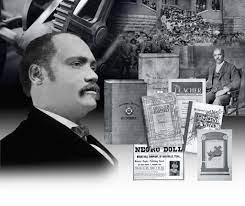


Meet Bedstead Boyd: Henry Boyd
Henry was born into slavery in 1843 in Mississippi, formally named Dick Gray which was the surname of his owner at the time. After his owner was killed during the American Civil War, Boyd took over operations of the Gray plantation.
After emancipation in 1867, Boyd left to work as a cowboy and changed his name to Richard Henry Boyd. Once he was free, he began to educate himself. He quickly learned how to read and attended Bishop College in Marshall, Texas. He spent time as an ordained minister where he produced pamphlets for use in Black Baptist Sunday Schools. He later established the National Baptist Publishing board which by 1906, was the largest African American publishing company in the United States - it was credited as the first publisher of old songs of Negro slaves.
From there, Henry went on to establish several pivotal businesses that changed the lives of Americans. One of them being the design and sale of African-American dolls. His National Negro Doll Company is believed to have pioneered the marketing of black dolls for black children for the purpose of black pride - no need for Black Barbie! Next, he established one of the first Black owned banks called the One-cent Savings and Trust Company Bank. This bank served the financial needs of African American depositors who believed that white-owned banks looked down on their small deposits. The bank, which opened its doors in 1904 and reported assets of $80,000 as of 1912, was still in business as of 2009 as the Citizens Savings Bank and Trust Company...but that was just the tip of the iceberg.
Boyd was an inventor and problem solver as well. While he was working at a store in Cincinnati - a white carpenter stumbled into the store too drunk to work. So to avoid drunk patrons from stumbling across the store, Boyd built the first counter for the storekeeper to separate him from patrons. This impressed the store keeper so much that he contracted him for other construction projects which quickly spread his talent all over town, enabling him to work with other white carpenters. He earned enough money to open up his own woodworking shop which grew to four buildings in Cincinnati. Here is where he built the Boyd Bedstead which significantly improved bed frames by utilizing a right and left wood screw process, with swelled rails, making for a sturdier fit to endure more stress. His design was wildly popular but he could not secure a patent for it until a fellow white cabinet maker applied for him. Not only was his bedstead breaking new ground, so were Boyd’s work practices. Employing 20-50 people at any given time, he operated an integrated workplace. In this setting Boyd’s bedstead became extremely popular and broke down barriers.
Despite all of this, He was an active member of the Underground Railroad, contributing funds and helping to coordinate the movement of escaped enslaved persons to safety. Boyd was an influential leader who left a lasting legacy of strength and resilience. He demonstrated what could be achieved with hard work, dedication, and the courage to pursue one's dreams. Thanks to Boyd, we can all get a good night's rest...Shoutouts to Bedstead Boyd!
Happy Black History Month



